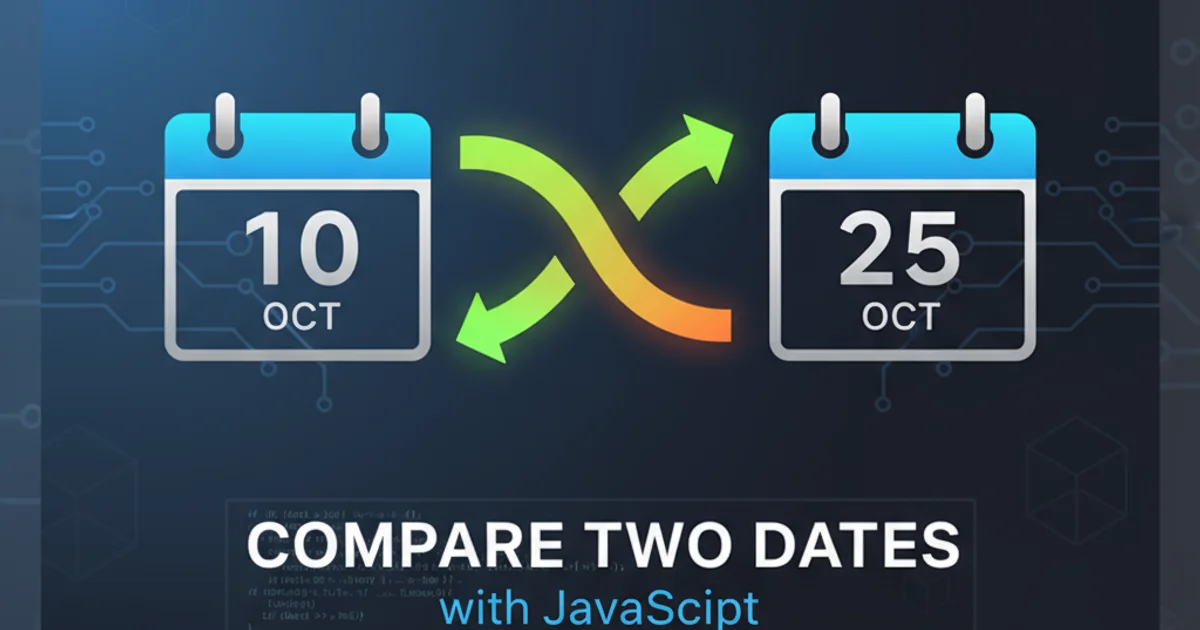Compare two dates with JavaScript
Categories:
Comparing Dates in JavaScript: A Comprehensive Guide

Learn various methods to effectively compare two Date objects in JavaScript, from simple equality checks to handling time zones and specific date parts.
Comparing dates in JavaScript is a common task, but it can be surprisingly nuanced due to the nature of Date objects and potential issues with time zones, milliseconds, and different comparison requirements. This article will guide you through the most effective and reliable ways to compare two Date objects, ensuring accuracy and avoiding common pitfalls.
Understanding JavaScript Date Objects
Before diving into comparisons, it's crucial to understand how JavaScript's Date object works. A Date object represents a single moment in time in a platform-independent format. It stores the number of milliseconds that have elapsed since January 1, 1970, 00:00:00 UTC (the Unix Epoch). When you create a Date object without specifying a time zone, it defaults to the user's local time zone, which can lead to unexpected results if not handled carefully.
Method 1: Comparing Millisecond Timestamps
The most robust and straightforward way to compare two Date objects is by converting them into their primitive millisecond timestamp values. The getTime() method returns the number of milliseconds since the Unix Epoch for a Date object. These numerical values can then be compared using standard comparison operators (<, >, <=, >=, ===, !==).
const date1 = new Date('2023-10-26T10:00:00Z');
const date2 = new Date('2023-10-26T11:00:00Z');
const date3 = new Date('2023-10-26T10:00:00Z');
// Get millisecond timestamps
const time1 = date1.getTime();
const time2 = date2.getTime();
const time3 = date3.getTime();
console.log(`date1 (${time1}) < date2 (${time2}): ${time1 < time2}`); // true
console.log(`date1 (${time1}) === date3 (${time3}): ${time1 === time3}`); // true
console.log(`date2 (${time2}) > date1 (${time1}): ${time2 > time1}`); // true
Comparing dates using getTime() for millisecond timestamps.
flowchart TD
A[Start]
B{Convert Date 1 to Milliseconds}
C{Convert Date 2 to Milliseconds}
D{Compare Millisecond Values}
E{Result: Date 1 < Date 2}
F{Result: Date 1 > Date 2}
G{Result: Date 1 === Date 2}
A --> B
A --> C
B --> D
C --> D
D -- "date1.getTime() < date2.getTime()" --> E
D -- "date1.getTime() > date2.getTime()" --> F
D -- "date1.getTime() === date2.getTime()" --> GFlowchart illustrating date comparison using millisecond timestamps.
Method 2: Direct Object Comparison (Caution Advised)
While JavaScript Date objects can be directly compared using relational operators (<, >, <=, >=), it's important to understand what's happening under the hood. When Date objects are used with these operators, JavaScript implicitly converts them to their primitive values (milliseconds since epoch) before comparison. This means date1 < date2 is effectively the same as date1.getTime() < date2.getTime().
const dateA = new Date('2024-01-15T12:00:00Z');
const dateB = new Date('2024-01-15T13:00:00Z');
const dateC = new Date('2024-01-15T12:00:00Z');
console.log(`dateA < dateB: ${dateA < dateB}`); // true
console.log(`dateA > dateB: ${dateA > dateB}`); // false
console.log(`dateA <= dateC: ${dateA <= dateC}`); // true
console.log(`dateA === dateC: ${dateA === dateC}`); // false (!!!)
console.log(`dateA.getTime() === dateC.getTime(): ${dateA.getTime() === dateC.getTime()}`); // true
Direct comparison of Date objects.
=== or !== for direct Date object comparison. These operators check for reference equality, meaning they will only return true if both variables point to the exact same object instance in memory, not if they represent the same point in time. Always use getTime() for strict equality checks.Method 3: Comparing Specific Date Parts (Ignoring Time)
Sometimes, you only need to compare the date part (year, month, day) and ignore the time. This is useful for checking if two dates fall on the same calendar day, regardless of the hour, minute, or second. To achieve this, you can normalize both dates to the start of their respective days (e.g., 00:00:00.000) or extract and compare individual components.
function isSameDay(d1, d2) {
return d1.getFullYear() === d2.getFullYear() &&
d1.getMonth() === d2.getMonth() &&
d1.getDate() === d2.getDate();
}
const today = new Date();
const tomorrow = new Date();
tomorrow.setDate(today.getDate() + 1);
const todayLater = new Date(today.getFullYear(), today.getMonth(), today.getDate(), 15, 30, 0);
console.log(`Is today and todayLater the same day? ${isSameDay(today, todayLater)}`); // true
console.log(`Is today and tomorrow the same day? ${isSameDay(today, tomorrow)}`); // false
// Alternative: Normalize to start of day (UTC to avoid local timezone issues)
function isSameDayNormalized(d1, d2) {
const normalizedD1 = new Date(Date.UTC(d1.getFullYear(), d1.getMonth(), d1.getDate()));
const normalizedD2 = new Date(Date.UTC(d2.getFullYear(), d2.getMonth(), d2.getDate()));
return normalizedD1.getTime() === normalizedD2.getTime();
}
console.log(`Is today and todayLater the same day (normalized)? ${isSameDayNormalized(today, todayLater)}`); // true
Comparing only the date part, ignoring time.
getUTCFullYear(), getUTCMonth(), getUTCDate()) or normalizing to UTC to prevent local time zone offsets from affecting the 'day' comparison, especially if dates originate from different time zones.